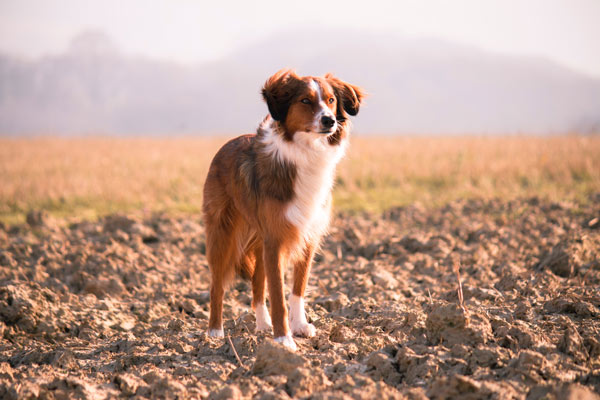Tips
- Obedience training really is not for the dog… it’s for YOU. This training teaches you how to communicate what you want your dog to do in a way that he understands. If you send your dog to someone else to train them, they learn to work with that person, not you. Take the time to learn how to train your dog, don’t pass the responsibility off to someone else. In some cases, you may need to have your dog learn the basics from someone else. But then, you should have the trainer work with you AND the dog together. This will make sure that you have the ability to continue the training at home. Check back in with the trainer for “tune up” sessions for you and your dog to keep everyone on track.[13]
- Remember that every dog is different. One dog might learn at a slower pace than another dog, and that’s okay. There is no such thing as an untrainable dog!
- Remember that dogs do not communicate the same way humans do.
- Do not let your dog “lean” on you either when you are standing up or sitting down. This is not a sign that they like you. This is a sign of dominance. The dog is encroaching into your space. You are the leader. Stand up and let your knee or foot nudge them out of your space. Praise the dog for getting up. Give the dog a command to lay down on their bed or go to their crate if you need to manage your personal space more effectively.
- If using hand signals, be sure they are unique and distinct for the dog to see and differentiate. There are standard dog training signals used for basic commands like “sit,” “stay,” etc. If you are unsure, ask your trainer or look online or in a book for a clearer picture of the body language to use.
- Be consistent. Make sure the command and hand signal use is the same each time.
- Use a harness instead of a choke chain.
- When using voice commands, use a firm voice. You mean for this dog to sit, so speak with meaning. Do not continue to repeat a command over and over again hoping the dog will eventually perform the command. Reinforce the command within two to three seconds if the command is not done and then praise the dog. You don’t want to be one of those people you see repeating “sit” 20 or so times until the dog sits. You want a sit on the first command, not the twentieth.
- Do not allow your dog to bite you, even playfully. This sets a bad precedent and it will be difficult for you to break them of this habit. Dangerous, aggressive dogs will need special training from an experienced dog trainer. In some cases, a veterinary behaviorist will need to become involved. At no time should you take on an aggressive dog without the proper training. It is too dangerous.
- If your dog is out of control, another good way to correct the behavior is to isolate them from the rest of the “pack”. Put them in their crate or kennel and ignore them. Isolation from the pack is dog language for “your behavior is unacceptable and we don’t like it.” Your dog will understand the message. They may whine and howl, but you have to ignore it. Think of it as a “time out” for your dog. When they are quiet and settled, let them out of the crate. Don’t forget to keep your dog exercised to help manage their energy level. Playing “fetch” is a great way to get the dog tired.
- Praise your dog often and lavishly.
- Training dogs requires a large amount of patience. It can be frustrating if you choose a breed wrong for your skill level or lifestyle. If you find you have made a poor choice, ask professionals for guidance. You may need to find a new home for the dog. Call your local rescue organization or veterinarian. Don’t wait until you and the dog have suffered. If you just don’t have the patience, then get yourself some personal one-on-one training from a reputable dog trainer. Nobody is a “born” dog trainer without getting educated.
- Don’t be cruel to your dog or hit them. If you strike your dog out of frustration, he will only learn to fear you.
- Clean up after your dog if they defecate on someone else’s property or in a public place. Doing this will ensure that others enjoy your dog as much as you do.
- When teaching your dog to speak, howling/barking yourself might make your dog bark.
- Never throw your dog your dinner scraps when eating. This will make him think you allow him to steal food, and he might take food from strangers. Also, when a dog begs turn away so he knows you don’t tolerate bad behavior. And be sure to treat your dog with love and have fun!
Warnings
- Use a collar and leash that is appropriate to your dogs size. Too loose or too tight collars can cause injury.
- Having a dog requires almost as much responsibility as having a child. If you’re not ready for that, don’t get a dog until you have done your research, and make adjustments to allow a dog into your life.
- Keep regular vet visits and stay up to date on vaccinations. You should also keep current on license requirements, and have your pet spayed or neutered as soon as they are old enough.
- Regular exercise for your dog will prevent him from being destructive in your home. Dogs get bored. When they get bored, they find ways to “entertain” themselves. That may include chewing your favorite shoes, destroying furniture, or barking nonstop. Avoid this problem by taking them for regular walks (twice a day is best). And it’s good for you too! “A tired dog is a good dog.” Exercise to the point of being tired is different for each individual.
Additional Resources
- Don’t Shoot the Dog by Karen Pryor
- Getting Started: Clicker Training for Dogs by Karen Pryor
- The Power of Positive Dog Training by Pat Miller
- 25 Stupid Mistakes Dog Owners Make by Janine Adams
- The Art of Raising a Puppy by the Monks of New Skete
- How to be Your Dog’s Best Friend by the Monks of New Skete
- The Mentally Sound Dog: How to Shape, Train and Change Canine Behavior by Gail I. Clark
Sources:
- http://www.aspca.org/pet-care/virtual-pet-behaviorist/dog-behavior/training-your-dog
- http://www.caninejournal.com/jack-russell-terrier-personality/
- http://www.pawnation.com/2014/03/13/low-energy-dog-breeds/3
- http://www.aspca.org/pet-care/virtual-pet-behaviorist/dog-behavior/teaching-your-dog-not-pull-leash
- http://www.aspca.org/pet-care/virtual-pet-behaviorist/dog-behavior/teaching-your-dog-come-when-called
- http://www.successdogs.com/dog-training-lessons/collar-grab-game/
- http://www.aspca.org/pet-care/virtual-pet-behaviorist/dog-behavior/training-your-dog
- https://www.cesarsway.com/dog-behavior/food-aggressive/food-aggression-and-what-to-do-about-it
- https://www.cesarsway.com/dog-behavior/food-aggressive/food-aggression-and-what-to-do-about-it
- https://positively.com/dog-behavior/basic-cues/leave-it/
- http://www.humanesociety.org/animals/dogs/tips/how_to_stop_barking.html
- http://www.humanesociety.org/animals/dogs/tips/crate_training.html
- http://www.aspca.org/pet-care/virtual-pet-behaviorist/finding-professional-help

